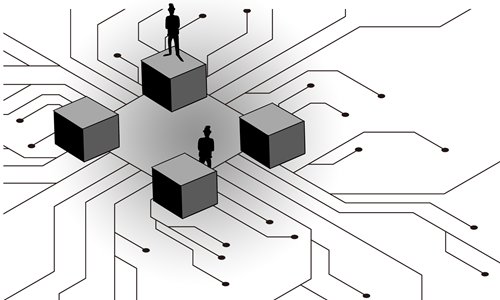HOME >> BUSINESS
Blockchain can be complement to financial system
By Tian Xiaolin Source:Global Times Published: 2019/7/9 20:58:40

Illustration: Luo Xuan/GT
In past years, online transactions have been surging greatly, and the demands in people's daily life are easier to meet thanks to fast financial services development. At the same time, financial innovations have their merits and demerits. Facebook is working with 27 partners to launch the cryptocurrency Libra in 2020. Is it a new kind of cryptocurrency or the embryo of a monetary system? How will this issue impact the global financial market and system in the long run and how will social life be shaped?
There is flaw in the traditional paper currency system. Financial problems in today's world can actually be regarded as debt problems, and worries about debt oftentimes triggers financial market volatility. To some extent, financial crisis is a reflection of debt crisis, whose lesson can be learned from the 2008 US sub-prime mortgage crisis, and the European financial crisis triggered by a debt crisis in 2012. In recent years, China's fast development has also led to accumulation of debt, which could become a potential threat to the stability of the financial market.
In reality, debt is an inevitable byproduct of a paper money system which used to be supported by tangible goods such as gold or sliver. However, with the uncertainty of banknote credibility, currency issuers can do nothing but continue issuing money in a continuous business cycle so as to balance the different social demands.
After society realizes the fragility of a credit system based on paper money, market players will begin to give up paper credit and instead turn to tangible assets such as real estate and commodities; they will mortgage these assets and purchase more assets with new credit from the mortgage, hoping to beat the market. In this way, more and more people and houses are involved, and the financial activities driven by new debt are permeating all of society. Almost every individual is in a state of acquiring new assets through borrowing. The prices of all social assets appear to be in a bubble due to debt support. That is why and how the potential financial crisis emerged.
Technology development facilitates the financial service demand. Under the support of modern information technology, the financial market has formed a series of new ecological chains of transactions. Fintech helps traditional financial institutions enter into small and scattered transactions, and internet tycoons easily spin off new departments to explore the financial service business to compete with traditional financial institutions.
Blockchain is a pattern of transaction records with marks that can never be tampered with. This pattern formed by parties involved in blockchain is different from the traditional banknote credit system, which could be easily manipulated. Blockchain technology is driven by the new transaction demand which traditional financial services cannot meet. If users need goods or services from other users, they can have the ability to purchase and pay by providing their own production of goods or services. For example, a computer supplier could sell a computer with a cryptocurrency price tag, and the sales revenue would be denominated by cryptocurrency.
Blockchain technology could be a good complement to the traditional financial system. The essence of blockchain is a small micro-monetary environment embodied in a large monetary environment. This small circle can interact with the large external circle - the exchange rate between the cryptocurrency and traditional currency system. In banknote era, the value of legal tender is mandated and distributed by a central bank.
However, the legal tender circulates in a wide range and can be hard pressed to cover the mutual interest exchanges between small regional economies' individuals, which are inevitable in their daily life. This provides new market opportunities and possibilities for using special substitutes to meet these transaction demands. As the technological gap between printed money and electronic money distribution becomes increasingly smaller, cryptocurrency naturally comes into being.
As a result, the feasibility and prospects of blockchain are beyond all doubt. It could open up the scope of services that the old economic model cannot achieve under its original conditions. Benefiting from the cross-border implementation, the scope of the new market opportunity and service demand is very large, with low-costs and perpetual transaction records, thus far exceeding the realm of paper money and credit conditions.
This kind of service ability is transnational, cross-age and cross-language, showing huge potential. As market history has shown, the power of supervision tends to be limited and lags behind technology development.
Although the service could be reduced or blocked due to regulatory constraints, the new technology, economic and financial forces formed by its trend could gradually grow into a new financial system for a better way of life.
The author is a senior economist at the Financial Group of SGCC and a senior visiting fellow of National Institute for Finance and Development in CASS. bizopinion@globaltimes.com.cn
Posted in: INSIDER'S EYE